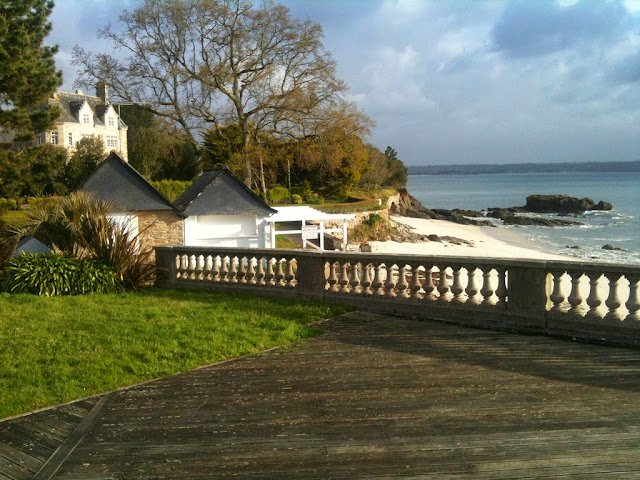Proust in Brittany
The Life of Proust
White Sands
During my slow residency
in Concarneau, I learnt that Proust had begun his first novel across the bay,
in Beg Meil. I wondered if my author, Georges Simenon had known this literary
link when he chose to over-winter in Concarneau in 1930. As the famous Trussel site tells us:
During November and December 1930, Simenon rented part of the villa "Ker-Jean", 11-15 Avenue des Sables-Blancs, northward along the coast from Concarneau (Finistère) in Brittany. Here he wrote the Maigret novel "Le Pendu de Saint-Pholien" (The Crime of Inspector Maigret).’ Quoted from the famous Trussel.com Maigret resource.
Le pays de Fouesnant
I arrived in Beg Meil on 11th April 2013 and checked-in to the Hôtel de la Cale. The cale is the wedge-shaped slipway into the sea. From the cale, I looked across Forest Bay and could make out the fortified walls enclosing Concarneau’s Ville close island. The manager, and I suspect, the owner of the hotel did everything. She showed me to my room, prepared a late lunch, served it in the quiet restaurant, and then she went to open the bar. I began to talk with her to try to find any points of reference for Proust’s sojourn in Beg-Meil. Unusually, she did know of the literary link; as other literary tourism researchers know, locals have often never heard of the author you are investigating. She produced an iPad from behind the bar and found the PDF of an article she knew well.
The article by Jean Le Foll was a wonderful piece
of well-researched but very readable writing. The author drew on Proust’s
letters to his friends, quotes from the novel, and made use of old post cards. All
the practices of a good travel writer. The piece ends with a facsimile of Proust’s
signature in a local hotel register. What more could you wish for? The perfect indexical
trace that your author had stayed here. Only later, like Minerva’s owl, did I
realise that I was reading a type of text that I would later call literary
travel writing. Even though the author, Jean Le Foll, had not used the
first-person I-narrator, all the other ingredients were there to create a catalyst
for the visitor. It was also a vade-mecum in that, with a little help from the
hotel manager, it gave me buildings to look for and identify in this small hamlet.
Proust on Holiday
Jean Le Foll (Le Foll
1995) places Proust on holiday on Concarneau Bay in September 1895 by using
Proust's correspondence and his incomplete and fragmentary novel Jean Santeuil. The novel was probably started around that
same time, as Le Foll notices that Proust writes about the poor quality paper
available at the hotel. A French version
of Jean Santeuil appears long after
Proust's death, in 1952 and Gerard Hopkins translated an edition into English in
1955 (this is still available in Penguin, referenced here as, Proust
1985). The novel opens with these lines
helping situate the action and giving insight, if like me, and Le Foll, you use
literary fiction as a source of data, into tourism in Brittany in the mid-1890s:
I had gone to spend the month of September with a friend at Kerengrimen, which in those days (1895) was a farm tucked away among apple orchards on the Bay of Concarneau, miles from any village. A great many Parisians and English people were in the habit of going there for the summer and using the house as an hotel. But the owner old Père Buzaret still called it a farm, and was at pains to see that it should look like one'. (Proust 1985, 3).
Reading on the Beach
In passing, too, the farmer was
already concerned with staged authenticity in his endeavour to retain the
rustic charm of the rural setting. Through literary detective work we learn that Marcel Proust then moves on. In a
letter to his friend back in Paris, Proust heads the notepaper Hôtel Fermont, Beg-Meil,
Finistère, September 1895. Beg-Meil
means the Mill on the Headland in Breton, something like, Millpoint. Le Foll has tracked this location down today
to being the Grand Hotel (Le
Foll 1995), with a view over the bay to Concarneau. Indeed in the novel, Proust
returns to describe this view, with the Glénan Islands (Proust 1985), the grey stone
Norman church and, reflected in the waters of the calm bay,
'the lovely fourteenth-century ramparts' (Proust 1985, 375) of Concarneau
itself. Proust's character, Jean is
beginning to provide future holiday-makers with a list of acceptable activities
to pursue at the seaside. For example,
the next section of the novel is called 'Reading on the Beach' (Proust 1985,
376),
It seems that the beauty of art can grow roots, can by degrees become part and parcel of the place it inhabits, a thing unique, something that we can never experience again unless we return to that one spot where first it came to us. (Proust 1985, 375).
It explains, too, what tourists with a whole season ahead of them, were seeking to experience. Nouvelles Frontières TUI now operate a large resort in Proust's Beg-Meil through its Club Vacances brand, with half- and full-board offerings in a newly-built complex of 24 apartments, 108 bungalows and 46 caravans (Nouvelles Frontières 2012). And the area, never shy of tourism, has rebranded itself as #rivierabretonne for a new generation of holidaymakers.
Please cite:
Mansfield, C. (2022) Across the Bay from Concarneau, Totnes: Travel Writers Online 4.9.2022 ISSN 2753-7803






Comments
Post a Comment
Thank you. Please do a SHARE too...